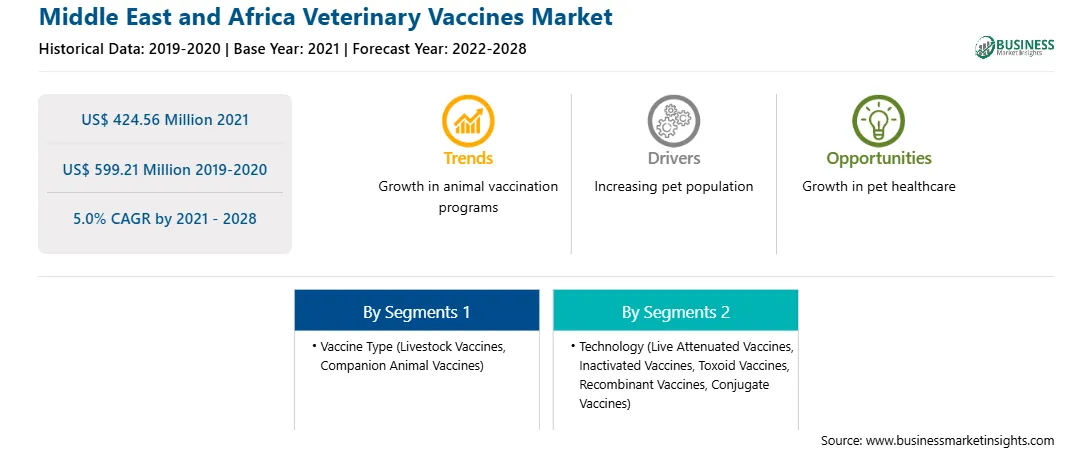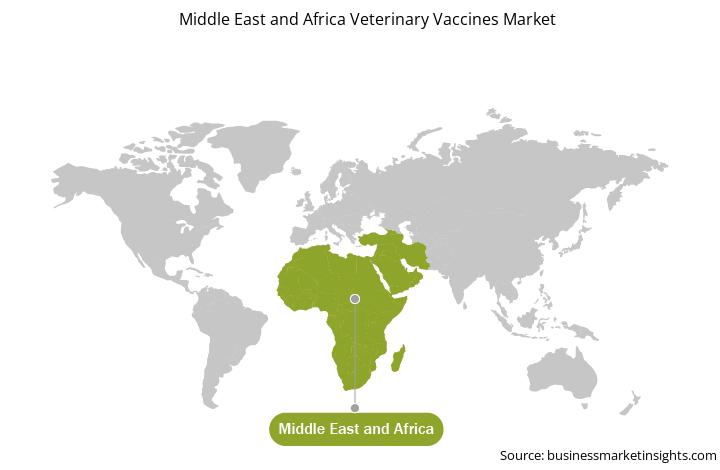Market Introduction
The MEA consists of three major countries namely United Arab Emirates (UAE), Saudi Arabia, South Africa, and rest of MEA. Saudi Arabia dominated the market in 2020. Saudi Arabia is one of the fastest-growing regions in the Middle East & Africa; whose growth is driven by the growing participation of the animal related companies in the country towards the expansion of their business operations which is expected to support the growth of the market in the country. For instances: In April 2020 Almarai based in the country has planned to expand its poultry related business. The company has an investment of SAR 275m (US$ 73.3 million). The rising incidence of foodborne and zoonotic diseases in MEA countries is fueling the demand for animal health in the country. For instance, Rabies in Saudi Arabia remains a public health problem and dogs and camels are the main reservoir and continue to present health risks for both human and animals throughout the country. Moreover, increasing demand for animal-based products for dietary use in the country is further propelling the growth. For instance, according to the United States Department of Agriculture (USDA), chicken meat production in Saudi Arabia in 2019 is forecast at 730,000 MT and is projected to increase to 750,000 MT in 2020. Chicken meat consumption this year is estimated at 1.33 million MT and is forecasted to reach 1.38 million MT in 2020. Thus, the above-mentioned factors are expected to fuel the Saudi Arabia Veterinary Vaccines Market in the forecast period.
In case of COVID-19, MEA is highly affected especially South Africa. The demand for veterinary vaccines decreased for a certain period until the new spread of the virus in animals hasn’t been confirmed. When the cases of several animals tested positive for the virus were reported in various parts of the region, a mix of established pharmaceutical companies involved in veterinary vaccines have mounted up R&D and manufacturing efforts to produce and develop vaccines, and drugs against the SARS-CoV-2 virus. The demand for veterinary vaccines has been increasing due to increasing incidences of zoonotic diseases, but the supply chain and service providers cannot satisfy the needs and have impacted largely. Supply disruption and medicine shortages of veterinary medicines have been observed in several countries, primarily due to the temporary lockdowns of manufacturing sites, export bans, and growing demand for medicine, for the treatment of COVID-19. Governments took measures to alleviate the supply of medicines. For instance, the South African Health Products Regulatory Authority issued guidance for companies responsible for veterinary medicines, with respect to the adaptations to the regulatory framework, primarily to address the challenges faced during this pandemic situation. The current veterinary vaccines markets in the MENA region differ considerably between the various nations. For example, high purchasing power and a cultural predilection for expensive foreign brands in Saudi Arabia have resulted in 85% of pharmaceuticals being imported.
Market Overview and Dynamics
The MEA veterinary vaccines market is expected to grow from US$ 424.56 million in 2021 to US$ 599.21 million by 2028; it is estimated to grow at a CAGR of 5.0% from 2021 to 2028. According to WHO, foodborne disease (FBD) is one of the primary causes of morbidity and mortality. The diseases can be developed by several chemical pollutants, bacteria, viruses, parasites, and biotoxins and are generally referred to as neglected diseases. The spread of FBD and its repercussions are major concerns to human health. The growing demand for animal products, coupled with increasing awareness about animal welfare, leads to changes in operational management. Like humans, pets and farm animals are susceptible to many diseases caused by bacteria, viruses, fungus, and parasites. Therefore, several techniques, such as veterinary vaccination, have been employed. The vaccines are licensed and manufactured under tight regulatory circumstances to ensure their safety, effectiveness, and quality. Veterinary vaccines against foodborne parasites improve animal health by reducing animal infections and help improve public health by managing an essential source of FBDs. In addition, vaccines safeguard farm animals by preventing or reducing the danger of certain infectious diseases. Healthy animals are the cornerstone of healthy eating; hence, immunizations help safeguard animal-made foods. The veterinary profession provides farmers with the immunizations needed to protect their animals' health and welfare. In animal husbandry, using antibiotics only when essential to protect animal health, means depending on non-antibiotic alternatives to control animal health, and making optimal treatment decisions regarding the antibiotic selection and treatment procedure when antibiotics are required. Vaccines are a possible alternative to intensive antibiotics. In a recent cross-border expert rating of alternatives to antimicrobial drugs in pig production, vaccinations were ranked in terms of perceived feasibility and among the top five alternative techniques in terms of perceived efficacy. So, rising prevalence of foodborne diseases and infections is expected to fuel the MEA market growth.
Key Market Segments
In terms of vaccine type, the livestock vaccines segment accounted for the largest share of the MEA veterinary vaccines market in 2020. In terms of technology, the live attenuated vaccines segment held a larger market share of the MEA veterinary vaccines market in 2020.
Major Sources and Companies Listed
A few major primary and secondary sources referred to for preparing this report on the MEA veterinary vaccines market are company websites, annual reports, financial reports, national government documents, and statistical database, among others. Major companies listed in the report are BIOVAC; Boehringer Ingelheim International GmbH; Ceva; Elanco; Hester Biosciences Limited; HIPRA; Merck & Co., Inc.; NEOGEN Corporation; Virbac; and Zoetis Inc. among others.
Reasons to buy report
MEA Veterinary Vaccines Market Segmentation
MEA Veterinary Vaccines Market - By Vaccine Type
MEA Veterinary Vaccines Market - By
Technology
MEA Veterinary Vaccines Market - By Country
MEA Veterinary Vaccines Market - Company Profiles
Strategic insights for the Middle East and Africa Veterinary Vaccines provides data-driven analysis of the industry landscape, including current trends, key players, and regional nuances. These insights offer actionable recommendations, enabling readers to differentiate themselves from competitors by identifying untapped segments or developing unique value propositions. Leveraging data analytics, these insights help industry players anticipate the market shifts, whether investors, manufacturers, or other stakeholders. A future-oriented perspective is essential, helping stakeholders anticipate market shifts and position themselves for long-term success in this dynamic region. Ultimately, effective strategic insights empower readers to make informed decisions that drive profitability and achieve their business objectives within the market.

| Report Attribute | Details |
|---|---|
| Market size in 2021 | US$ 424.56 Million |
| Market Size by 2028 | US$ 599.21 Million |
| CAGR (2021 - 2028) | 5.0% |
| Historical Data | 2019-2020 |
| Forecast period | 2022-2028 |
| Segments Covered |
By Vaccine Type
|
| Regions and Countries Covered | Middle East and Africa
|
| Market leaders and key company profiles |
|
The geographic scope of the Middle East and Africa Veterinary Vaccines refers to the specific areas in which a business operates and competes. Understanding local distinctions, such as diverse consumer preferences (e.g., demand for specific plug types or battery backup durations), varying economic conditions, and regulatory environments, is crucial for tailoring strategies to specific markets. Businesses can expand their reach by identifying underserved areas or adapting their offerings to meet local demands. A clear market focus allows for more effective resource allocation, targeted marketing campaigns, and better positioning against local competitors, ultimately driving growth in those targeted areas.

The Middle East and Africa Veterinary Vaccines Market is valued at US$ 424.56 Million in 2021, it is projected to reach US$ 599.21 Million by 2028.
As per our report Middle East and Africa Veterinary Vaccines Market, the market size is valued at US$ 424.56 Million in 2021, projecting it to reach US$ 599.21 Million by 2028. This translates to a CAGR of approximately 5.0% during the forecast period.
The Middle East and Africa Veterinary Vaccines Market report typically cover these key segments-
The historic period, base year, and forecast period can vary slightly depending on the specific market research report. However, for the Middle East and Africa Veterinary Vaccines Market report:
The Middle East and Africa Veterinary Vaccines Market is populated by several key players, each contributing to its growth and innovation. Some of the major players include:
The Middle East and Africa Veterinary Vaccines Market report is valuable for diverse stakeholders, including:
Essentially, anyone involved in or considering involvement in the Middle East and Africa Veterinary Vaccines Market value chain can benefit from the information contained in a comprehensive market report.